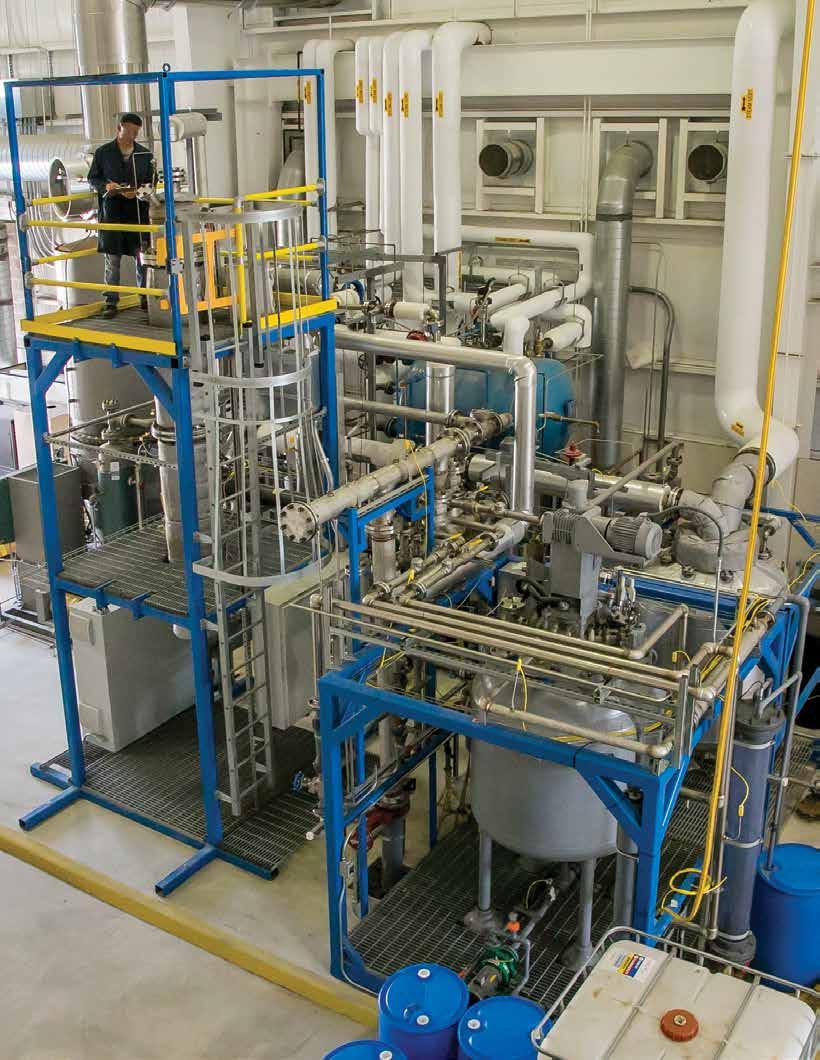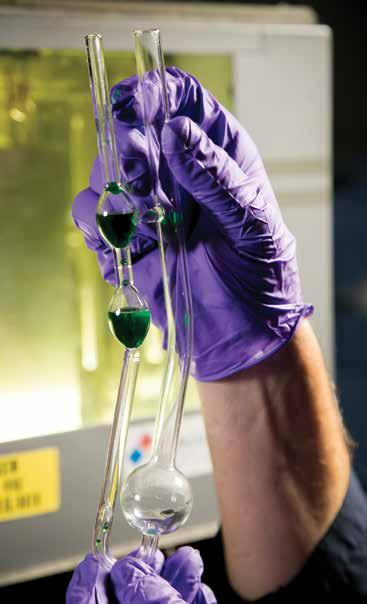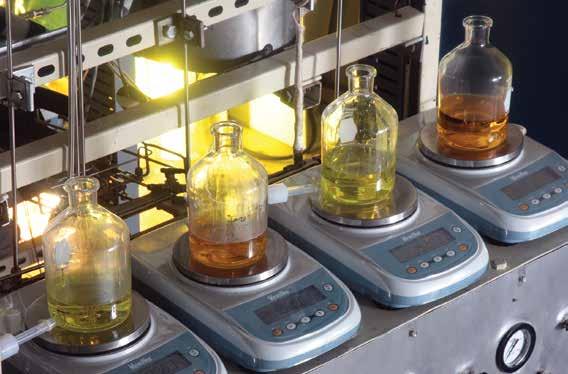
10 minute read
From Biomass to Biofuel
The promise of green, renewable fuels beckons many a would-be entrepreneur to develop biomass into cost-effective fuels, using crops grown for that purpose or recycled materials, such as agricultural waste or used cooking oil.
The chemistry to produce biofuels is fairly straightforward, if somewhat involved. It can be done, but advancing the refining process from the grease trap or the beaker to a profitable, commercial-level factory can be another story. Often, a processor labors long and hard to produce a crude biofuel, only to discover that there’s still much work and expense ahead before the new crude can become a market-ready product that meets fuel specification standards.
Southwest Research Institute’s chemical engineers have helped a number of clients meet their objectives and avoid expensive mistakes. With our pilot-scale laboratory equipment and development techniques, SwRI helps clients upgrade and refine crude biobased products more efficiently while meeting the needs of the marketplace.
WHAT’S A BIOFEEDSTOCK?
A biofeedstock or biomass is a renewable, biological material that can be used as or converted into a fuel or energy product. Biomass currently used to make hydrocarbon fuels includes plant-, animal-, and algae-based materials grown specifically for that purpose, or recycled materials such as cooking grease. These concentrated plant materials, combined with certain alcohols and crop oils, often enjoy some chemical advantages over crude oil. For example, they can contain a higher level of combustible hydrogen and a lower level of undesirable sulfur, while their boiling point is similar to that of most hydrocarbon fuels and intermediate products. All of this makes them desirable for conversion into fuel products such as diesel, jet fuel, and naphtha, an intermediate product similar to gasoline and benzene, often used as a solvent or fuel. The chemical similarity of converted biomass to crude oil has stimulated some oil refiners and catalyst manufacturers to adapt their oil-refinery processes and products to produce biofuels. So far, so good, but making new fuel sources is not the end of the story.
However they are derived, biofeedstocks tend to vary in makeup and uniformity, which complicates their suitability for commercial use. This variability can affect refinery operations and yield uneven product throughput and quality. Experience has shown that there is no one-size-fits-all approach to refining biofeedstocks. Consequently, biofuel processors need to recognize that a combination of processes may be needed to create commercial products, which can increase their production costs. The bottom line: Effective processing can be the difference between profit and loss, or between feasible and no-go.
And that’s where SwRI’s chemical engineering pilot-scale laboratories come in, where each proposed processing scheme can be examined individually and weighed for efficiency and profitability. Once the data are in and a viable process is chosen, engineering and design work can begin on an operating plant to refine the client’s biofeedstock. Using this data in technoeconomic analyses can predict the future costs of building and operating a biofeedstock refining plant. Such preliminary work can be a vital intermediate step for a company on the path to building a successful business operation. Three recent cases illustrate how pilot-plant development has taught some lessons and also helped clients achieve their biofuel objectives.
ALGAE OIL
Oils derived from algae grown in water offer some distinct advantages: They are easily renewable. And, because they grow in a “flowable” medium, they can be easily transported, extracted, and processed. Other traits are not so desirable: High oxygen content in the fatty acids of algae oil can reduce engine peak power, and paraffins produced during processing have a higher freezing point than many fuels do. This can complicate matters, as is the case for jet fuel, which is exposed to frigid temperatures at high altitudes. One client who wished to use algae oil as a feedstock planned to use a commercial catalyst to deoxygenate the oil and lower its freezing point before distilling it to reach the targeted flash-point and end-point temperatures needed for commercial products. Preparing the commercial catalyst was relatively easy, but SwRI’s 8-liter reactor pilot plant wasn’t efficient at exploring the best processing conditions. For that, we used a 0.1-liter pilot plant that could quickly change the conditions and would require less feedstock per test. We determined the best conditions of pressure, temperature, and flowrate for production while saving the client valuable time.
When the process was switched to the 8-liter pilot plant for larger-scale production, we discovered that a rapid increase in gas pressure revealed a plugged preheat segment of the reactor bed packed with seemingly inert aluminum oxide. The chemical compounds of these “inerts” are made up of aluminum and oxygen and are commonly called alumina. Changing the alumina didn’t stop the clog, and we found that alumina itself could react to deoxygenate the fatty acids during preheating. Meanwhile, the presence of unfilterable cellular material from the algae also contributed to obstructions.
Ultimately, we discovered that it was necessary to dilute the feedstock and to tap the reactor frequently to dislodge the alumina at the top of the reactor bed for the processing to be successful. Using these approaches, we were able to produce a trial batch of oil that met specification, providing essential information for the client.
ETHANOL BIOFUELS
Ethanol from fermented or hydrolyzed cellulose is a versatile and sustainable feedstock. Cellulose, the fibrous component of plants, is mostly inedible to humans and animals, except for cud-chewing animals such as cows and sheep, which have special digestive systems.
SwRI’s machinery program develops and utilizes novel power plant technology SwRI uses this second-generation for a variety of applications. For instance, engineers developed a hot gas pilot plant to scale up and evaluate expander and recuperator for a 1 MW sCO biofuel processing methods. 2 demonstration loop located at SwRI.

SwRI uses this second-generation pilot plant to scale up and evaluate biofuel processing methods
Hydrolysis breaks down the fibrous cellulose by adding water and using enzymes to convert complex cellulose into simple sugars such as glucose, which are then fermented and distilled into ethanol or grain alcohol.
Ethanol serves as a component of gasoline and can be converted into jet fuel as well as a source of other commercial products. This alcohol burns easily, which makes it an attractive green feedstock. However, it also tends to absorb moisture and can contribute to corrosion. And like algae oil, it has a relatively high oxygen content.
To create jet fuel, a client was using a proprietary catalyst to build complex organic molecules, or polymers, from simpler ethanol molecules. This technique, called oligomerization, is a fairly short polymerization process. Catalysts are materials used with reactive substances that increase the rate of a chemical reaction without undergoing any permanent chemical change themselves. The particular catalyst for this oligomerization was effective in creating the right chemical reactions, but was ultrasensitive to metals and sulfur, which deactivated or “poisoned” the catalyst. This sensitivity required feedstocks to be pretreated, adding complexity to the overall process. This particular process also required another complicated step to isolate byproduct water produced during synthesis, something seldom required for petroleum hydrocarbons. SwRI used its 8-liter pilot plant, separating its three reactor beds to create different phases for removing metals and the sulfur before performing the oligomerization process. Other modifications allowed online sampling and water removal; all this was done rapidly, saving the client months of time.
Processing the ethanol went well, but sampling and analyzing the selectivity of the catalyst were challenging. Selectivity is the ability of a particular catalyst to favor the intended reactions rather than undesirable side-reactions leading to byproducts. In addition, the oxygenated compounds in different samples reacted with the lines used to draw samples from the pilot plant. Ultimately, we installed new fluorocarbon sample lines that were heated to prevent oxygenate separation so we could efficiently characterize samples and deliver accurate data about the process.

The composition of materials produced during pilot plant operations can be rapidly assessed using instruments such this carbon-hydrogen analyzer. Chemists can then adjust the process “on the fly” with timely, accurate data.

SwRI can accurately determine the product properties of novel liquids, such as viscosity measurements at unusual temperatures or with reactive liquids. Algae slurries can be particularly challenging.
CONTINUOUS BIODIESEL PRODUCTION
Biodiesel is often made by chemically reacting lipids — vegetable oil, soybean oil, and animal fats — with an alcohol to create fatty acid esters that are easily mixed with conventional diesel fuel. These chemical compounds have physical characteristics closer to those of fossil fuels than those of raw vegetable oil.
Chemists typically use batch-processing techniques to produce esters for blending into diesel fuel. The usual process combines methyl alcohol with a strong base, typically sodium hydroxide or lye, to produce the desirable esters. Industry uses whole crop oils and restaurant waste oils as the raw material. The main byproduct is “wet” glycerol, which is produced in a watery layer. The primary ester product floats on top of the wet layer. While this process consumes mostly food crop oils, other crops, particularly plants that grow on arid land, produce oils suitable for making biodiesel. What was missing was a more efficient way to make the esters.
An Institute client improved on the batch technology using a proprietary catalyst that SwRI developed with internal funds, which performs the reaction normally provided by sodium hydroxide. This catalyst not only allows continuous ester production, with high selectivity for methyl esters when converting the crop oils with methanol, but also eliminates the sodium hydroxide liquid waste.
In a serendipitous development, a baseline test using excess methanol yielded no glycerol byproduct at all. Instead, the process produced a variety of oxygenates, including abundant amounts of commodity chemicals of commercial value. In today’s marketplace, the widespread batch-production of biodiesel has drastically reduced the commercial value of “wet” glycerol, so this continuous process is not only more efficient but produces more valuable secondary products as well.
PILOTING FOR THE FUTURE
Computer simulations and semi-empirical methods help determine the limitations of pilot-scale systems, such as the three examples cited in this article. Traditionally, pilot plant data provide the basis for the design of commercial plants. Process modeling has matured to the point that small- or even pilot-scale studies are routinely accepted by industry for whole-plant performance and economics, without the intermediate step of further validation. Frequently, business models move toward commercialization without even budgeting for intermediate-scale testing.
Pilot-scale testing not only serves as an insurance policy for commercialization; it also provides an early opportunity to discover the peculiarities of a new technology or how to enhance an existing process to provide added value.
SwRI has extensive facilities and capabilities for designing, fabricating, and operating chemical processes from the test tube to commercial plant scale-up. As these three case studies show, our pilot plants help bridge the gap between a promising laboratory experiment and the development of commercial products and processes, a path that is often challenging for clients to navigate successfully.
Questions about this article? Contact Erwin at (210) 522-2389 or jimell.erwin@swri.org.

SwRI develops catalyst-based techniques to process biofeedstocks into fuels and other products. This versatile catalyst tester allows chemists to compare yields, temperatures, and pressures of up to four scenarios simultaneously.




